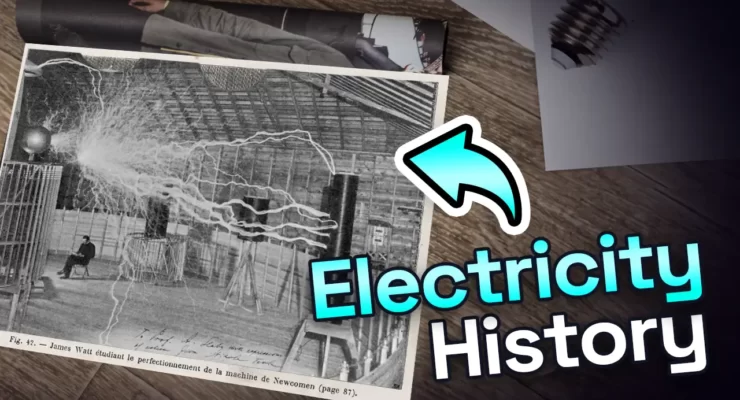Fast read
Electricity's history traces back to ancient times, with the Greeks' discovery of static electricity around 600 BC. William Gilbert, in the 17th century, laid foundational understanding, while Benjamin Franklin's kite experiment connected lightning to electricity in 1752. Alessandro Volta's voltaic pile in 1800 marked a leap, allowing continuous current power generation.
Michael Faraday's dynamo in 1831 enabled practical electricity production. Thomas Edison and Joseph Swan's light bulb in 1878 revolutionised lighting.
Nikola Tesla and George Westinghouse made important contributions to the field of electricity. Tesla's work focused on AC systems. Westinghouse chose to use AC for power transmission. Their efforts helped advance the field of electricity.
Contributions from people like James Watt and Andre Ampere have helped shape the modern electrical landscape. They have shown how electricity has evolved from ancient times to modern marvels through working together.
Unraveling the History of Electricity: From Ancient Discoveries to Modern Marvels
Ancient Origins: The Discovery of Static Electricity
The history of Electricity has been around for a really long time, even before people knew much about it. Around 600 BC, ancient Greeks noticed that when they rubbed amber (a type of tree resin) with fur, it attracted things like hair. This was one of the earliest discoveries of what we now call static electricity.
Clues from ancient times, like from the Romans and Persians, also suggest they might have played with basic batteries. These batteries could have been used to make light or do other simple tasks.
These early encounters with electricity show how it has always been a part of human history. From being a curious thing to becoming essential for almost everything we do today, electricity has come a long way. It powers our homes, runs our gadgets, and drives our modern world forward.
Looking back at where we started, we see how people have always been curious about the world around them. And electricity, from its mysterious beginnings to now, continues to be a big part of that story.
Early Scientific Inquiry: The 17th Century History of Electricity
In the 17th century, there was a significant leap forward in understanding electricity. A notable figure in this progress was English physician William Gilbert. He introduced the term “electricus” to describe the force produced by rubbing certain substances together. Gilbert’s work laid the foundation for further investigations into the nature and properties of electricity by subsequent scientists.
Gilbert’s contribution was pivotal because it provided a way to describe and study the phenomenon systematically. Before his time, electricity was often observed as a curious but poorly understood occurrence. By introducing a term to encapsulate this force, Gilbert enabled others to delve deeper into its workings.
His work sparked interest and curiosity among scientists across Europe, leading to experiments and observations that expanded our understanding of electricity. Gilbert’s term “electricus” became widely adopted, establishing a common language for discussing electrical phenomena.
Gilbert’s work was a major breakthrough in the study of electricity. It sparked centuries of scientific research and technological progress in the field.
Benjamin Franklin and the Kite Experiment
In 1752, Benjamin Franklin, a famous American, did a cool experiment with a kite during a storm. He tied a metal key to the kite’s string and flew it. When lightning struck the kite, Franklin saw sparks jump from the key to his hand. This experiment showed that lightning and electricity are related.
But, it’s essential to know that Franklin’s experiment didn’t teach us entirely new things about electricity. Instead, it just confirmed that lightning acts like small electric sparks.
Even though Franklin’s experiment didn’t reveal groundbreaking discoveries, it got people excited about studying electricity. It paved the way for more research into how to protect against lightning and how to use electricity in useful ways.
Franklin’s kite experiment is still famous today because it shows how curiosity and bravery can lead to big discoveries.
Alessandro Volta and the Birth of Batteries
Italian physicist Alessandro Volta made a monumental discovery in 1800 when he invented the voltaic pile, one of the earliest electric batteries. This invention was the first to generate a continuous electric current, paving the way for future advancements in electrical technology.
Michael Faraday’s Dynamo: Generating The History of Electricity
In 1831, a scientist named Michael Faraday made something called an electric dynamo. This machine could produce electricity continuously and reliably. Faraday’s idea was pretty straightforward: he moved a magnet inside a coil of wire. This invention was a big deal because it gave us a way to make electricity that we could use regularly.
Before Faraday’s dynamo, electricity was more of a curiosity than something practical. But with his invention, we could create electricity whenever we needed it. This led to the development of electric lights and power systems that we still use today.
Faraday’s work changed the world by giving us a way to harness electricity for everyday use. His invention paved the way for the modern electric systems that power our homes, businesses, and cities.
Thomas Edison, Joseph Swan, and the Incandescent Light Bulb
In 1878, two inventors, Thomas Edison and British scientist Joseph Swan, separately created something amazing: the incandescent filament light bulb. This invention was a game-changer because it gave people a practical way to light up their homes and streets using electricity.
Edison and Swan invented the light bulb. This changed how cities were electrified. It made electric lighting accessible to everyone.
Before their invention, lighting was mostly done using candles, oil lamps, or natural gas lamps, which weren’t very safe or convenient. But with the incandescent light bulb, people could have bright, reliable light with just the flip of a switch.
Edison and Swan’s light bulbs transformed the world, making nighttime safer and more productive. They set the foundation for the widespread use of electric lighting, which is still a crucial part of our everyday routines.

Nikola Tesla and the AC Revolution
Nikola Tesla, a smart inventor from Serbia who later moved to America, changed how we use electricity. He made things like AC motors and a system to send electricity to homes and businesses.
Before Tesla, electricity was harder to use. But with his inventions, it became easier and better. AC motors made machines work better, and his system helped electricity travel long distances without losing power.
Nowadays, we still use Tesla’s ideas for our electricity. They help power our homes, run our gadgets, and keep our world going. Tesla’s work made a big difference and continues to inspire inventors today.
George Westinghouse and the AC-DC Battle
American inventor George Westinghouse acquired and improved Tesla’s AC motor, leading to the adoption of AC as the standard for electrical power transmission. This marked a turning point in the “War of Currents,” solidifying AC as the future of electricity.
The Collective Effort: Contributions from Various Minds
Over time, many clever people, like James Watt, Andre Ampere, and George Ohm, helped make electricity what it is today. Each of them made important discoveries that changed how we understand and use electricity.
James Watt improved the steam engine, which played a big role in generating electricity. Andre Ampere figured out how electric currents work and made important laws about them. George Ohm discovered how resistance affects electric currents, which is crucial in designing electrical systems.
All of these scientists worked together to build the foundation for modern electricity. Their discoveries and ideas paved the way for the electrical systems we rely on today, powering our homes, businesses, and technologies.
Conclusion: A Collaborative Journey through the History of Electricity
While the history of electricity is often associated with individual inventors, it is, in reality, a collaborative journey involving multiple brilliant minds. Electricity has evolved over centuries of scientific inquiry and innovation, from ancient discoveries to modern marvels. It has forever changed how we live and interact with the world.



